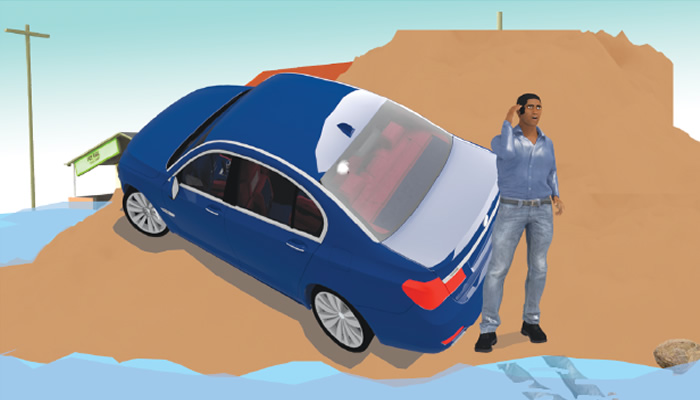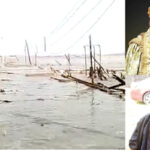
Flash flooding, according to Scientific American, an American science magazine, is a specific type of flooding that occurs in a short time frame after heavy rainfall or high-intensity rainstorms. Such floods typically occur in areas near rivers or lakes but they can also occur in places with no water nearby.
They are often characterised by short response time, and have the potential to severely impact and damage communities in different climatic settings all over the world.
A 2022 report by the United Nations Children’s Fund revealed that at least 27.7 million children have been affected by flooding in 27 countries worldwide.
In Nigeria, the number of people affected by floods in 2022 was estimated at over 3.2 million, with over 600 fatalities.
The Director-General of the National Emergency Management Agency predicted that the country will experience severe flooding in 2023 and called on emergency responders, development agencies and individuals to work assiduously to avert a repeat of the incidents which occurred during last year’s flash floods.
A safety adviser, Mr Isaac Idoko, explained that public safety information on how to be safe during flash floods was vital for people regardless of whether they lived in a flood-prone or high-risk area.
Here are seven ways to ensure safety during flash floods:
Create a personal or family emergency plan
Idoko said, “It is important to have a personal or family emergency safety plan if a flash flood occurs. If you work or live in a place that is close to a river or lake, it could be a high-risk area for having a flash flood after hours of rainfall. In such a case, plan to move to higher ground quickly if necessary.”
He noted that this should also involve having an emergency supply kit.
This, he noted, should include essential items such as drinking water, food, clothing, medications, flashlights and important documents which will help sustain individuals and their families for up to three days in the event they are isolated from their homes.
Be alert to changing weather conditions
According to Idoko, it is helpful to be sensitive to when a storm is approaching in order to readily prepare for safety and make necessary adjustments.
“Be on the lookout for what is called ‘storm clouds,’ it is often a towering kind of cloud that spreads out across the sky.
If you are going on an outdoor activity when you see a storm approaching, it would be best if you consider postponing it. You then start preparing by bringing in objects or items that could be swept away or damaged during flooding.
“Elevate the items in your rooms to prevent them from being damaged and ensure that you unplug sensitive electronic equipment before the flooding occurs and avoid touching electrical equipment if you are standing in water.”
Avoid wading through water
The safety expert pointed out that it was dangerous for people to wade through floodwater no matter how tempting it might be.
“There are instances where one is stranded at a spot due to flash floods. The best thing to do is to wait. Avoid walking through floodwater; this is how most drowning occurs during flash floods. It is often easy for the swiftly moving water to knock the person off his or her feet,” he added.
To minimise risks of electric shocks, Idoko advised that no contact should be made with electrical wires, outlets or power lines which might have been already submerged in water
Don’t drive through floodwater
Idoko said, “If you are driving a car when a flash flood occurs, make sure you avoid driving on bridges over fast-moving water. It could be a washout bridge and can lead to accidents. People should also avoid driving through flooded roads because cars can also be swept away in two feet of moving water.
“The large pool could look shallow and motorable, but this is often a wrong assumption people make during flash floods. If your car is trapped in rapidly moving water, stay in the vehicle. If you notice that the water is rising inside the vehicle, seek refuge on the roof.”
Be wary of buildings
“If a building where you want to take shelter from a flood is also submerged in water, then do not enter the building. Building collapses can occur during or after a flood, so it is very important to check for structural damage and inspect the building you wish to stay for foundational cracks or other damage.
“Also, check for flooded electrical systems and smell of burning insulation of strange smell. Examine the walls, ceilings, floors, doors and windows for risk of collapsing,” Idoko added.
Ensure personal safety
Idoko noted that, “The most common injuries people sustain during a flood disaster is falling due to slippery grounds or surfaces and cut feet. So you need to wear sturdy shoes and make sure you have a flashlight with you.
“Watch out also for animals that might have entered into your space with the floodwaters. There have been instances where snakes and even scorpions found their way into people’s houses after a flood. In any case, ensure that your house is well checked and if there are minor wounds, seek medical care.”
Make adequate repairs
The safety expert advised people returning to their homes after a flood to throw away food or water that had contact with floodwaters and restrict their children from playing in flooded areas.
“Keep the window open for ventilation. Disinfect every object that was in contact with the flood water and repair all the appliances or sewage system that may have been damaged during the flood,” he added.
A quality health and safety expert, Jamiu Badmos, noted that floods often affected people with disabilities more.
He said, “After all safety measures have been put into place after a flood, residents should be good neighbours and check on family, friends, and PWDs, the elderly, those who live alone, those with medical conditions, and those who may need extra help. These are the demographic more affected by disasters such as floods.”





